350 Search Results for aided language input
February 29, 2012
by Carole Zangari -
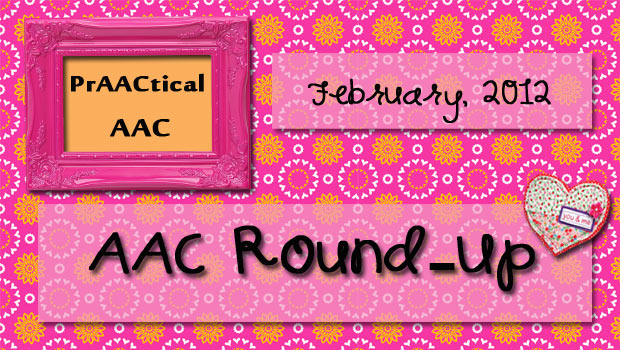
The Fives 5 Features of AAC Apps & SGDs that Make Us Happy 5 Little Things that Make a Big Difference in AAC Intervention 5 Ways SLPs Can Support Friendships for People who Use AAC 5 Ways to Help People With AAC Needs Develop Inner Speech 5 Great Places to Get AAC Therapy Materials 5 Creative Ways to Use the Big Mack and Other Talking Switches 5 Genius Reasons to Discover & Love MeeGenius 5 Quick Wishes for SGDs & Apps 5 Reasons Why A ‘Speech-Only’ Approach Isn’t Good Enough 5 Sources of AAC Inspiration Strategy of the Month: Aided Language Input AACtual Progress: Learning to Use Aided Language Input Using the AAC Device/App: Getting the Team On Board Why We Love Aided Language Input Strategy of the Month: Aided Language Input Video of the Week: Aided Language Input Demo Teachers in Action: Aided Language Input Other Posts Malls &... [Read More...]
February 21, 2012
by Robin Parker -
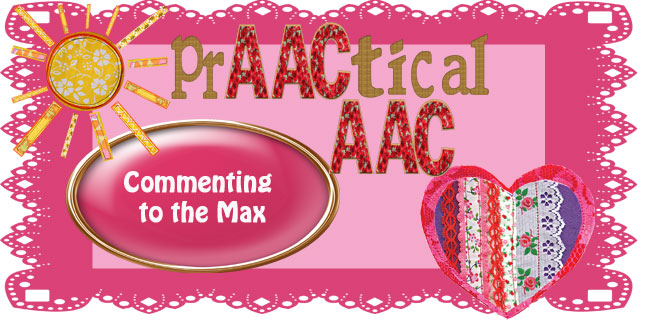
Communication and language involves so much more than requesting. Without much effort, communicators with typical language development and even delayed language development communicate for many reasons. Showing or telling about a shared interest comes easily and is a form of commenting to communicate. Commenting is one of the most social reasons that we communicate. So, it makes perfect sense that children with social communication disorders may not have an easy time with these social aspects of communication and language. We know many children who frequently use long (or short) sentences to say ‘I want the blue truck’, ‘I want the big ball’, or even ‘Can I have the cold drink’. They may even communicate frequently to ask for toys, games, or activities of their choice. All of the requesting is GREAT but not enough to be part of comprehensive conversations and social language interactions. It is not that children with... [Read More...]
February 18, 2012
by Carole Zangari -
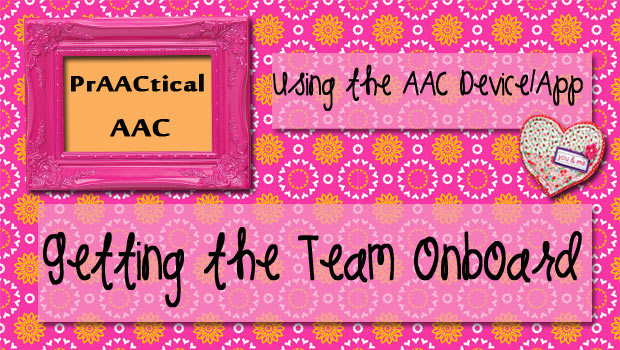
Families and professionals often share a common frustration when a new SGD, communication aid, or AAC app is introduced: Getting people to use it. Whether we’re fighting with insurance companies or navigating the educational maze, our attention is often consumed by getting access to the device. Then, oh happy day, it arrives. Round 1 is over. We won! We get it set up (no small feat). We start teaching the communicator to use it and everyone shares the excitement of this new tool. For awhile, anyway. – And then, reality sets in. – We realize that learning to communicate through this tool and building language skills with it is a p-r-o-c-e-s-s. There’s an arc to that process. It slowly sinks in that this new tool is necessary but not sufficient for real communication and language learning to occur. Though we knew that having the AAC device or app wasn’t going... [Read More...]
February 17, 2012
by Carole Zangari -
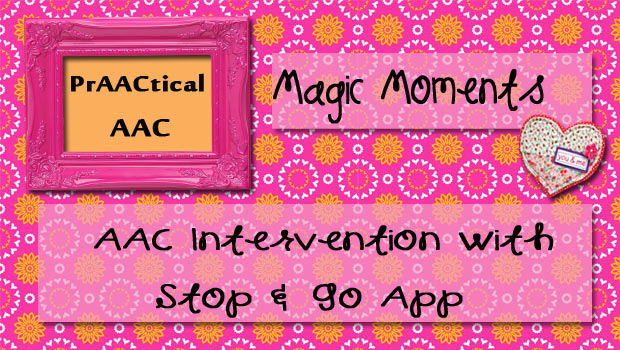
We’re always looking for engaging ways to give our preschool children practice with their core word vocabulary. Stop and Go by ShortStack is an app that will get your little friends using core language without even realizing how much practice they are getting. — We love the simple structure of the app, which shows vehicles stopped at a traffic light. We see and hear the name of the vehicle and then press the green light for the vehicle to go. It has an English or a Spanish option and lots of interactive elements to try and then talk about. — Magic Moments with Stop and Go 1. Core Word Practice: As expected, there are tons of opportunities for the child to move the vehicles in this app. Using the strategy of controlled access, we can elicit ‘stop’ and ‘go’ multiple times in this game. 2. More Core Word Practice –... [Read More...]
January 6, 2012
by Robin Parker -
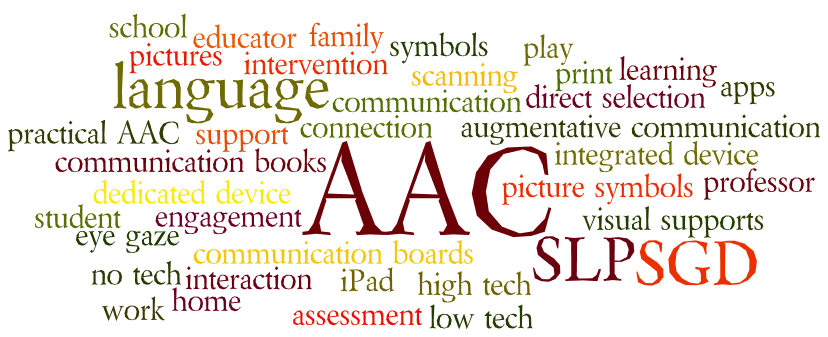
We know that ALL people communicate. However, when someone has communication challenges, their signals may not always be obvious or conventional. Here is our Quick Step Guide to getting to know about someone’s specific communication. Using these steps will help facilitate spontaneous communication and move communication along the continuum of conventionality and symbolism. 1. Observe: What are they doing that is potentially communicative? Look for clues in behaviors. Consider proximity, persistence, expressions, repetition, intensity, or anything else that might expresses a message. More ideas from the National Consortium on Deaf-Blindness. Great information that is applicable to a wide range of early communicators. Don’t rule this out until you’ve looked at it. 2. Interpret: What does that behavior mean? Think about what would they ‘say’ if there was no communication problem. It can be a positive message (‘I want that’, ‘oh come on pretty please’) or a negative message... [Read More...]
September 16, 2023
by Carole Zangari -
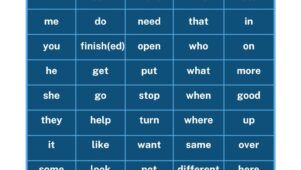
About Week 2 Welcome to the second week of your Stepping into AAC journey! Now that you have a communication board (or other AAC tool) to use and an idea of what to expect over the next 19 weeks, we’re going to dive into some concepts that will help you begin using this with your AAC learner. We will explore the following concepts this week: Word List: Get a preview of all the words that we’ll be focusing on over the course of this program. Shared Attention: Gain an understanding of the crucial role that joint attention plays in learning and communication and how to maximize it for the benefit of your AAC learner. Multimodal Communication: Learn about different forms of communication and how to incorporate them when supporting a beginning AAC user. Modeling Language with AAC: Consider how to help your AAC learner expand their language abilities by giving... [Read More...]
July 20, 2023
by Carole Zangari -
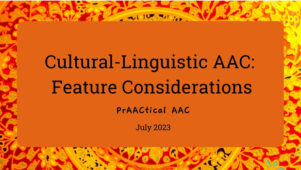
Our series on multilingual AAC support guest authored by BilingüeAAC continues. In today’s post, Sarah Lee addresses issues specific to features of AAC apps and SGDs. BilingüeAAC is a group of SLPs with a shared belief in providing evidence-based intervention strategies and resources to bilingual Spanish AAC clients, families, caregivers, and professionals. If you are new to this series, you can check out the previous articles using the links below. Bilingual AAC Support from Monolingual Professionals: An Introduction Cultural-Linguistic AAC Intervention: A Framework for Consideration Gathering Information from Families with Questionnaires and Surveys Most of us WANT to provide culturally-linguistic responsive bilingual Spanish AAC intervention, but we don’t feel confident without knowing/speaking the language. In an effort to foster Spanish heritage language development and empower the monolingual SLPs*, we have created context-specific templates using the sociocultural approach (Soto & Yu, 2014) for the monolingual English-speaking SLP*. We will be referencing... [Read More...]
April 10, 2023
by Carole Zangari -
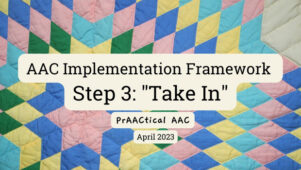
Welcome to the next installment of Vicki Clarke’s AAC Implementation Framework. In today’s post, Vicki focuses on the role of the communication partner, with prAACtical ideas for helping them utilize key support strategies that facilitate AAC learning. New to this series? You find the earlier posts using the links below. Steps to Learning Step 1, Determining the Target Step 2: TRAIN ::::::::::::::::::::::::::::::::::::::::::::::::::::::::::::::::::::::::::::::::::::::::::: AAC Implementation Framework Step 3: “Take In” In our journey towards teaching autonomous communication, Step 3: “Take In” is dedicated to the partner’s role, which involves modeling the use of AAC to communicate words and messages in real-world situations. The aim of this stage is to help the student learn when and how to communicate using AAC, as well as to develop a clear understanding of the practical application of these skills by watching their partner’s interactions. This process mirrors the way in which infants and toddlers acquire... [Read More...]
February 17, 2020
by Carole Zangari -
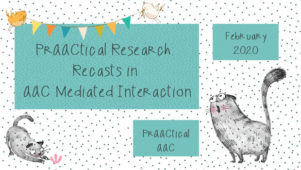
Today, we welcome back guest author Dr. Kathy Howery for another wonderful discussion of an important AAC research article. Dr. Howery’s work in AT and special education spans three decades and her research uses phenomenological methods to increase our understanding of the lived experience of people who use AAC. She works with the Ministry of Education low incidence team, and as a consultant to schools and school districts across Alberta focusing primarily on children and youth with complex communication needs. In this post, Dr. Howery reviews an important article describing research on recasting in AAC mediated conversations. Recasts in AAC Mediated Interaction Soto, G., Clarke, M. T., Nelson, K., Starowicz, R., & Savaldi-Harussi, G. (2020). Recast type, repair, and acquisition in AAC mediated interaction. Journal of Child Language, 47, 250-264. https://doi.org/10.1017/S03035000919000436 What this article is about (the focus of the research)? This article focuses its attention on the power of... [Read More...]
December 12, 2019
by Carole Zangari -
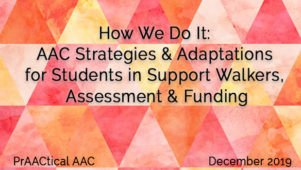
How can we reduce the negative impact of significant motor challenges on children who use AAC and are not independently mobile? Today, we conclude Christine Wright-Ott’s series on this topic. Christine is an Occupational Therapist and consultant at The Bridge School in Hillsborough California. She authored the chapter, Mobility, in several editions of the book, Occupational Therapy for Children. Christine lectures at universities and conferences including ATIA, Closing the Gap, ISAAC, ISS, and AAC by the Bay. If you missed the earlier posts in this series you can catch up via the links below. Part 1: From Wheelchair to Walker: The Cascading Benefit of Hands-Free Mobility Part 2: From Wheelchair to Hands-free Walker for Preschool Children with AAC Needs Part 3: How We Do It: A Support Walker Mobility Program for Elementary Students with AAC Needs ::::::::::::::::::::::::::::::::::::::::::::::::::::::::::::::::::::::::::::::::::::::::::: AAC Strategies, Adaptations for Students in Support Walkers, Assessment & Funding AAC Strategies and... [Read More...]









